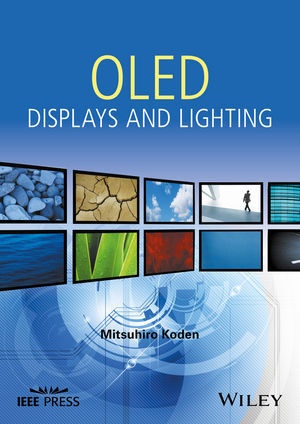Ulteriori informazioni
Informationen zum Autor Dr. Koden is currently a Professor at the Innovation Center for Organic Electronics (INOEL) at Yamagata University, Japan. He is the author/ co-author of more than 70 papers and articles, and is the inventor of more than 150 patents. Prof. Koden has extensive R&D industrial experience from his 30 year career at Sharp Corporation. Klappentext Explains the fundamentals and practical applications of flat and flexible OLEDs for displays and lightingOrganic light-emitting diodes (OLEDs) have emerged as the leading technology for the new display and lighting market. OLEDs are solid-state devices composed of thin films of organic molecules that create light with the application of electricity. OLEDs can provide brighter, crisper displays on electronic devices and use less power than conventional light-emitting diodes (LEDs) or liquid crystal displays (LCDs) used today. This book covers both the fundamentals and practical applications of flat and flexible OLEDs.Key features:* Covers all of the aspects necessary to the design and manufacturing of OLED displays and lighting.* Explains the fundamental basic technologies and also related technologies which might contribute to the next innovation in the industry.* Provides several indications for future innovation in the OLED industry.* Includes coverage of OLED vacuum deposition type and solution type materials.The book is essential reading for early career engineers developing OLED devices and OLED related technologies in industrial companies, such as OLED device fabrication companies. Zusammenfassung Explains the fundamentals and practical applications of flat and flexible OLEDs for displays and lighting Organic light-emitting diodes (OLEDs) have emerged as the leading technology for the new display and lighting market. Inhaltsverzeichnis Preface ix 1 History of OLEDs 1 References 10 2 Fundamentals of OLEDs 12 2.1 Principle of the OLED 12 2.2 Fundamental Structure of the OLED 14 2.3 Features of the OLED 15 3 Light Emission Mechanism 17 3.1 Fluorescent OLEDs 17 3.2 Phosphorescent OLEDs 19 3.3 Thermally Activated Delayed Fluorescent OLEDs 21 3.4 Energy Diagram 21 3.5 Light Emission Efficiency 23 References 24 4 OLED Materials 25 4.1 Types of OLED Materials 26 4.2 Anode Materials 27 4.3 Evaporated Organic Materials (Small Molecular Materials) 29 4.3.1 Hole Injection Materials 29 4.3.2 Hole Transport Materials 32 4.3.3 Emitting Materials and Host Materials in Fluorescent Emission Layer 33 4.3.4 Emitting Materials and Host Materials in Phosphorescent Emission Layer 34 4.3.5 Emitting Materials and Host Materials in TADF Emission Layers 42 4.3.6 Electron Transport Materials 43 4.3.7 Electron Injection Materials and Cathodes 45 4.3.8 Charge-Carrier and Exciton Blocking Materials 46 4.3.9 N-Dope and P-Dope Materials 49 4.4 Solution Materials 50 4.4.1 Polymer Materials 50 4.4.2 Dendrimers 61 4.4.3 Small Molecules 69 4.5 Molecular Orientation of Organic Materials 70 References 71 5 OLED Devices 75 5.1 Bottom Emission, Top Emission, and Transparent Types 75 5.2 Normal and Inverted Structures 79 5.3 White OLEDs 81 5.4 Full-Color Technology 84 5.4.1 RGB-Side-by-Side 87 5.4.2 White + CF 87 5.4.3 Blue Emission with Color Changing Medium (CCM) 88 5.5 Micro-Cavity Structure 89 5.6 Multi-Photon OLED 91 5.7 Encapsulation 94 5.7.1 Thin Film Encapsulation 99 5.7.2 Desiccant Technologies 100 References 100 6 OLED Fabrication Process 103 6.1 Vacuum Evaporation Process 103 6.1.1 Mask Deposition 104 6.1.2 Three Types of Evaporation Methods 104 ...

